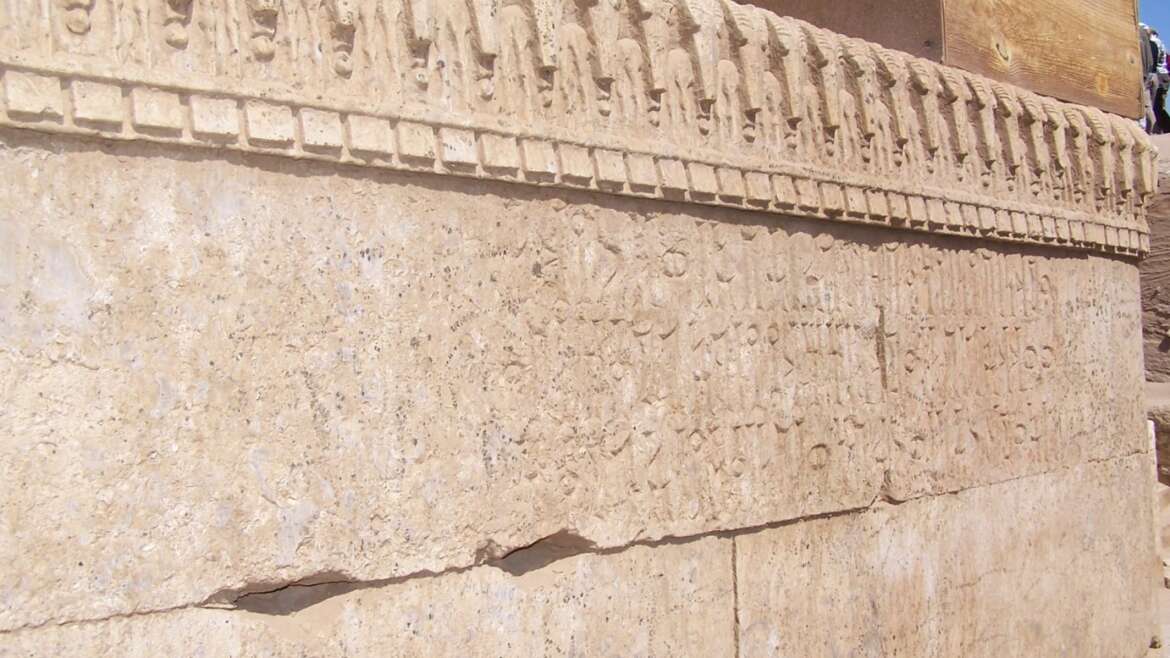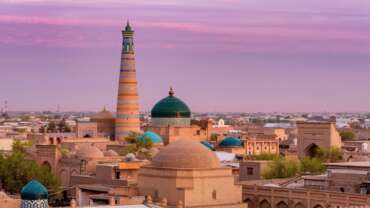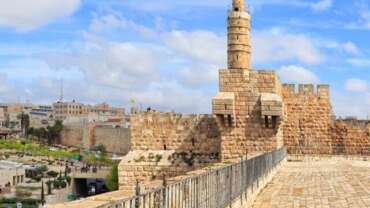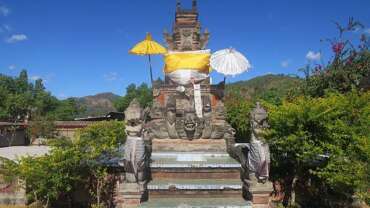Yemen - Yeah Man!
Yemen, country situated at the southwestern corner of the Arabian Peninsula. It is mostly mountainous and generally arid, though there are broad patches with sufficient precipitation to make agriculture successful. The people speak various dialects of Arabic and are mostly Muslims (see Islam).
The history, culture, economy, and population of Yemen have all been influenced by the country’s strategic location at the southern entrance of the Red Sea—a crossroads of both ancient and modern trade and communications routes. In the ancient world, the states that occupied the area known today as Yemen controlled the supply of such important commodities as frankincense and myrrh and dominated the trade in many other valuable items, such as the spices and aromatics of Asia. Because of its fertility as well as its commercial prosperity, Yemen was the location of a number of ancient kingdoms; for that same reason, it was known to the ancient Romans as Arabia Felix (Latin: “Fortunate Arabia”) to distinguish it from the vast forbidding reaches of Arabia Deserta (“Desert Arabia”). Later, Yemen was the place where coffee (Arabic: qahwah) was first cultivated commercially, and, before the introduction of coffee plants to other parts of the world, it was long the sole source of that precious bean.
History of Yemen
The pre-Islamic period
For more than two millennia prior to the arrival of Islam, Yemen was the home of a series of powerful and wealthy city-states and empires whose prosperity was largely based upon their control over the production of frankincense and myrrh, two of the most highly prized commodities of the ancient world, and their exclusive access to such non-Yemeni luxury commodities as various spices and condiments from southern Asia and ostrich plumes and ivory from eastern Africa. The three most famous and largest of these empires were the Minaean (Maʿīn), the Sabaean (Sabaʾ, the biblical Sheba), and the Ḥimyarite (Ḥimyar, called Homeritae by the Romans), all of which were known throughout the ancient Mediterranean world; their periods of ascendancy overlap somewhat, extending from roughly 1200 BCE to 525 CE.
The Romans began expanding their power and influence to the Red Sea in the 1st century CE and soon learned the secrets of the Yemeni traders—namely, the true source of luxury commodities provided by the Yemenis and how to exploit the monsoon winds to traffic between Red Sea ports and those of southern Asia and eastern Africa, where these treasures could be found. It was only a matter of time before Yemen, unable to compete effectively against imperial Rome, went into economic decline, and the subsequent loss of revenue made it impossible for Yemen to maintain its extensive cities and attendant facilities. The most famous instance was the failure to maintain the Great Dam at Maʾrib—the heart of a monumental irrigation project and one of the engineering marvels of the ancient world. Its rupture sometime in the 6th century CE constitutes the symbolic end to the long era of the Yemeni trading kingdoms.
The last Ḥimyarite king, Dhū Nuwās (Yūsuf Ashʿar; c. 6th century CE), was a convert to Judaism who carried out a major massacre of the Christian population of Yemen. The survivors called for aid from the Byzantine emperor, who arranged to have an army from the Christian kingdom of Aksum (in what is now Ethiopia) invade Yemen in order to punish Dhū Nuwās. The leader of the Aksumite campaign was Abraha. After overthrowing Dhū Nuwās and conducting a massacre of Jews, Abraha stayed on to rule the Yemen. His attempt to extend his rule farther north, into the Hejaz (the western coastal region of the Arabian Peninsula), was ultimately a failure, though his effort to besiege Mecca is reported in the Qurʾān.
The Ḥimyarites grew resentful of the Aksumites, who they came to view as usurpers, and sought the support of the Sāsānian dynasty of Persia to expel them. By obliging, the Persians added the satrapy of Yemen to their domains. The last Persian governor of Yemen apparently converted to Islam in 628 CE, accepting the political dominance of the Muslim community.
The advent of Islam
Islam spread readily and quickly in Yemen, perhaps because of the century of economic decline and the atrocious behaviour of both Jews and Christians during that time. The Prophet Muhammad sent his son-in-law as governor, and two of Yemen’s most famous mosques—that in Janadiyyah (near Taʿizz) and the Great Mosque in Sanaa (said to have incorporated some materials from earlier Jewish and Christian structures)—are thought to be among the earliest examples of Islamic architecture.
Despite the fact that Muhammad’s first successor, the caliph Abū Bakr (served 632–634), managed to unify the Arabian Peninsula, it was not long before Yemen once again demonstrated its fractious nature. Often when the caliph sent a representative to put down rebellions or deal with other problems, the representative would establish his own dynasty. Such was the case with Muḥammad ibn Ziyād, who early in the 9th century founded the city of Zabīd as his capital. (See Ziyādid dynasty.)
For the history of Yemen, however, the most important event after the triumph of Islam was the introduction in the 9th century of the Zaydī sect from Iraq—a group of Shiʿi who accepted Zayd ibn ʿAlī, a direct descendant of Muhammad, as the last legitimate successor to the Prophet. Much of Yemeni culture and civilization for the next 1,000 years was to bear the stamp of Zaydī Islam. That same span of time was host to a confusing series of factional, dynastic, local, and imperial rulers contesting against one another and against the Zaydīs for control of Yemen. Among them were the Ṣulayḥids and the Fāṭimids, who were Ismāʿīlīs (another Shiʿi branch); the Ayyūbids; and the Rasūlids, whose long rule (13th–15th century) firmly established Sunnism in southern and western Yemen.
Yemen next appeared on the world stage when, according to one account, the leader of a Sufi religious order discovered the stimulating properties of coffee as a beverage, probably about the beginning of the 15th century. As a result, Yemen and the Red Sea became an arena of conflict between the Egyptians, the Ottomans, and various European powers seeking control over the emerging market for Coffea arabica as well as over the long-standing trade in condiments and spices from the East; this conflict occupied most of the 16th and 17th centuries. By the beginning of the 18th century, however, the route between Europe and Asia around Africa had become the preferred one, and the world had once again lost interest in Yemen. In the meantime, the coffee plant had been smuggled out of Yemen and transplanted into a great variety of new and more-profitable locales, from Asia to the New World. The effect of the redirection of trade was dramatic: cities such as Aden and Mocha (as the name would suggest, once a major coffee centre), which had burgeoned with populations in excess of 10,000, shrank to villages of a few hundred.
The age of imperialism
Developments in the 19th century were fateful for Yemen. The determination of various European powers to establish a presence in the Middle East elicited an equally firm determination in other powers to thwart such efforts. For Yemen, the most important participants in the drama were the British, who took over Aden in 1839, and the Ottoman Empire, which at mid-century moved back into North Yemen, from which it had been driven by the Yemenis two centuries earlier. The interests and activities of these two powers in the Red Sea basin and Yemen were substantially intensified by the opening of the Suez Canal in 1869 and the reemergence of the Red Sea route as the preferred passage between Europe and East Asia. As the Ottomans expanded inland and established themselves in Sanaa and Taʿizz, the British expanded north and east from Aden, eventually establishing protectorates over more than a dozen of the many local statelets; this was done more in the interest of protecting Aden’s hinterland from the Ottomans and their Yemeni adversaries than out of any desire to add the territory and people there to the British Empire. By the early 20th century the growing clashes between the British and the Ottomans along the undemarcated border posed a serious problem; in 1904 a joint commission surveyed the border, and a treaty was concluded, establishing the frontier between Ottoman North Yemen and the British possessions in South Yemen. Later, of course, both Yemens considered the treaty an egregious instance of non-Yemeni interference in domestic affairs.
The north became independent at the end of World War I in 1918, with the departure of the Ottoman forces; the imam of the Zaydīs, Yaḥyā Maḥmūd al-Mutawakkil, became the de facto ruler in the north by virtue of his lengthy campaign against the Ottoman presence in Yemen. In the 1920s Imam Yaḥyā sought to consolidate his hold on the country by working to bring the Shāfiʿī areas under his administrative jurisdiction and by suppressing much of the intertribal feuding and tribal opposition to the imamate. In an effort to enhance the effectiveness of his campaigns against the tribes and other fractious elements, the imam sent a group of Yemeni youth to Iraq in the mid-1930s to learn modern military techniques and weaponry. These students would eventually become the kernel of domestic opposition to Yaḥyā and his policies.
Yemeni independence allowed the imam to resuscitate Zaydī claims to “historic Yemen,” which included Aden and the protectorate states, as well as an area farther north that had been occupied only recently by an expanding Kingdom of Saudi Arabia, including the province of Asir and some important areas around the Najrān oasis and Jīzān. These areas became a point of conflict with the house of Saʿūd. Yaḥyā, of course, did not recognize the standing Anglo-Ottoman border agreement.
The British, on the other hand, retained control over the south, which they considered strategically and economically important to their empire. Friction between the imamate and Britain characterized the entire interwar period, as Imam Yaḥyā sought to include the south in the united Yemen that he perceived to be his patrimony. The British in the meantime were consolidating their position in the south. The most important change was the incorporation of the Ḥaḍramawt and its great valley into the protectorate system—the result of the labours of British diplomat Harold Ingrams, who negotiated the famous “Ingrams’s Peace” among the more than 1,400 tribes and clans that had been feuding in that district for decades.
By the end of World War II in 1945, dissatisfaction with Yaḥyā and his imamate had spread to a rather wide segment of Yemeni society, including both secular and Muslim reformers and modernists, other elements of the traditional elite, and even the ʿulamāʾ (religious scholars). This tide of dissent culminated in early 1948 in the assassination of Yaḥyā and a coup by a varied coalition of dissidents. Much to the consternation of the plotters, however, Yaḥyā’s son Aḥmad succeeded in bringing together many of the tribal elements of the north, overthrew the new government, and installed himself as imam. Although Imam Aḥmad ibn Yaḥyā had indicated that he supported many of the popular political, economic, and social demands (e.g., creation of a cabinet with real responsibilities, abandonment of the principle of economic autarky, and the establishment of free public education), his own government soon resembled his father’s in nearly all respects. An attempt on Aḥmad’s life in 1955 only increased repression; indeed, his paranoia concerning the loyalty of major tribal elements prompted actions that eventually cost his son tribal support during the civil war after the 1962 revolution.
People of Yemen
Ethnic groups
The people of Yemen overwhelmingly consider themselves Arabs, but they have tended to divide themselves between northern and southern groups, a historical division that has linguistic roots but which is otherwise difficult to trace. Yemenis of northern origin, for example, are said to have descended from Mesopotamians who entered the region in the 1st millennium BCE, and they claim ancestry of the biblical figure Ismāʿīl (Ishmael). The southern group, which represents the old South Arabian stock, claims descent from Qaḥṭān, the biblical Joktan.
Ethnic minorities include the Mahra, a people whose roots are unclear and who occupy a part of eastern Yemen, as well as the island of Socotra, and who speak a variant of the ancient Himyaritic language. (See Mahra Sultanate.) On the Tihāmah coastal plain, in-migrations from Ethiopia and Somalia have occurred over many centuries. There is a clear African admixture in the coastal population as well as a distinct social group known as the Akhdām, who perform menial tasks and are the closest thing to a caste in Yemen. In the far north there are still small remnants of the once-large Jewish communities (most migrated to Israel after 1948), while in the area of Aden and the eastern regions there are distinct Somali, Indonesian, and Indian elements in the population, legacies of the British colonial era as well of economic and political ties extending back over two millennia.
Among Arab groups, tribal affiliation is another deep-seated component of social identity. Some tribal confederations have histories spanning more than two millennia. These affiliations continue to serve as a key basis for political and social organization throughout the country, although the postindependence governments of both South Yemen and, to a lesser extent, North Yemen set out to eradicate what then were considered reactionary cultural institutions. Although efforts toward detribalization were at least in part effective, subsequent events indicated that such identifications were still socially, economically, and politically relevant.
Languages
More than nine-tenths of Yemenis speak some dialect of Arabic as their first language, and Modern Standard Arabic—the literary and cultural language of the broader Arab world—is taught in schools. There are several main dialects, but minor differences often occur within smaller geographic areas. The Arabic of the rural areas of the south is still heavily influenced by the ancient South Arabian languages. A dialect of Judeo-Arabic spoken by the Jewish community has fallen almost entirely out of use in Yemen. Hindi, Somali, and several African languages are spoken in pockets. Several ancient Semitic dialects, including Bathari, Mehri, and Socotri (Soqotri), remain in a chiefly oral capacity. Those languages have tended to recede as literacy in Arabic has become more common.
Religion
Throughout society, the broadest distinctions between population groups are based not on ethnicity but on religious affiliation. Islam is the state religion, and the Sunni branch of Islam, represented by the Shāfiʿī school, predominates. The Shiʿi minority consists of the Zaydī school, which has long been politically dominant in the mountainous highlands of the north, and the Ismāʿīlīs, now a relatively small group found in the Haraz region of northern Yemen and in Jabal Manakhah, the mountainous area west of Sanaa. The non-Muslim community is very small, consisting mostly of foreign visitors and workers. All are free to worship as they wish—including the Jewish community—but, as in most conservative Muslim countries, proselytizing of Muslims by non-Muslims is illegal.
Historically, Yemen has had its share of Islamic militants, particularly since the return of combatants who fought in the 1980s on the side of the mujahideen (Arabic: mujāhidūn, “those who engage in jihad”) in the Afghan War (1978–92).
Cultural Life of Yemen
Yemen is a part of the Islamic world and as such reflects many of the contemporary trends in Islam. Most Yemenis are Muslim and are tolerant of non-Muslims as well as of the various branches of Islam. While proud of their Islamic heritage, Yemenis are also intensely proud of their pre-Islamic history, including that of the Sabaʾ and Ḥaḍramawt kingdoms. In their extensive networks of overland and maritime trade, the ancient Yemenis encountered myriad cultures and civilizations. There is ample evidence of Greek, Roman, Indian, Indonesian, and Chinese influence on various aspects of both traditional and contemporary Yemeni culture.
Daily life and social customs
Yemen shares in many of the customs and lifeways that are found in other parts of the Arab world. Culture is intensely patriarchal, and households usually consist of an extended family living in a single domicile or family compound. The head of the family is the eldest male, who makes all significant decisions for the family and its members. Women play a secondary role in running the household and raising the children and, in rural areas, helping to work the family farm. Though nearly one-fourth of Yemeni women obtain work outside the home, a woman traditionally earns most of her social status through bearing children, particularly males. The birth of a male child is considered one of the most important social events in Yemeni society and is followed almost immediately by a circumcision ceremony. Though prohibited by law in 2001, female genital cutting still occurs, taking place primarily in private and varying significantly by region.
Marriages are almost always arranged and frequently are undertaken at a young age. Although the opinion of a potential bride or groom might be solicited on the issue, the final decision on marriage belongs with the head of the household. As in many parts of the Islamic world, endogamy (the practice of marrying someone from within one’s own kin group) is common, the preferred marriage being with a paternal first cousin of the opposite gender. The practice of mahr (bride-price, given by the father of the groom) is a usual part of the marriage ceremony. Divorce is not common, but neither is there a stigma attached to it. Men may have as many as four wives at the same time, though in practice it is rare for a man to take more than one wife.
Yemeni society is tribally based, and trust and assurance most often are measured by degree of consanguinity. Families are very close and are the focus of the individual’s primary devotion; one’s second allegiance is to the tribe, an extended family unit that ordinarily traces its ties to a common eponymous ancestor. In rural Yemen, state authority is weak, and disputes between tribes are frequently solved through violence. The art of the feud is still quite real, and, as a consequence, Yemen is a gun culture. Virtually every household has at least one weapon, and men and boys often carry firearms in public. Even when not carrying a pistol or a rifle, most Yemeni males—particularly those belonging to a rural tribe—will carry a dagger, the traditional janbiyyah (or jambiyyah), a short, broad, curved blade sheathed on a belt worn across the abdomen and serving as a signal of one’s status within social and tribal hierarchies.
The traditional nature of Yemeni society is reflected in choices of attire, though the native dress of Yemen differs somewhat from that found in other conservative parts of the Arabian Peninsula. Men sometimes wear the full-length, loose-fitting thawb—frequently with a jacket over it—but more often the traditional fūṭah, a saronglike wraparound kilt, is worn with a shirt. The turban is a common type of head covering, and a finely woven bamboo hat (shaped somewhat like a fez) called a kofiya (or kofia) is a more formal choice of headgear. There are various forms of dress for women, depending on the social role a woman plays and where she lives. In North Yemen, women in cities and towns wore the sharsaf, a black skirt, scarf, and veil ensemble that covers the entire body. In South Yemen, the regime that succeeded the British after 1967 vigorously opposed this women’s dress code, and this opposition prevailed especially in the towns and cities. In the countryside, clothing for women tends to be somewhat more utilitarian and may consist of a dress or robe that provides for a greater range of movement and under which, in some parts of Yemen, it is not uncommon for a woman to wear a pair of loose slacks known as a sirwāl. Also in the countryside, a woman’s face may or may not be covered, and dresses are sometimes sewn from brightly coloured fabric. Working women frequently wear a broad-brimmed straw hat (dhola) to ward off the sun.
Traditional Yemeni cuisine is broadly similar to that found in other areas of the Arabian Peninsula, but it is also heavily influenced by the cuisine of eastern Africa and South Asia. The major meats are chicken, mutton, and goat. Other staples include potatoes, onions, and tomatoes. There are several types of bread; unleavened flat bread is typical. A popular dish in Yemen is saltah, a stew of lamb or chicken that is heavily spiced with fenugreek and other herbs. Tea is a common drink, and coffee is very popular. Alcoholic beverages are considered culturally and religiously inappropriate, though they are available.
Shaharah Bridge

Soon after passing Al Qabai, the famous seventeenth century bridge comes into view, which join the Jebel Al Amir and the Jebel Feesh. This astonishing work was constructed by the architect Salah Al –Yaman to connect the settlement of Shaharah tough limestone blocks.
A cursory glance at the base of the arch reveals the existence of earlier attempts to bridge this narrow yet precipitous gap. The bridge, along with Dar al-Hajar and the walled city of Shibam, has become one of the main images of Yemeni tourism, and it appears on the 10YR coin.
The biggest problem with visiting Shaharah has been its greatest asset throughout the centuries – its sheer inaccessibility. A trip to visit the village necessitates a good deal of time, and usually involves an overnight stay.
So, if you view the trip as a means to experience remote mountain villages and glimpse a peek at tribal culture, with the added bonus that you will be able to witness an amazing architectural masterpiece, the benefits will start to weight in a favour of a trip.
Even so, when you reach the bridge, try to refrain as long as you can from taking a picture. Far too many tourists simply snap a picture and then retreat to the safety of their hotels within five minutes.
Sit down, take in the scenery, and enjoy it. (Granted, the view of the bridge may be too much for the camera finger to bear. Just remember to enjoy the trip while you are there, as well as vicariously through photos later).












